101 East investigates how the illegal wildlife trade is wiping out rare species on the Indonesian island of Sulawesi.
Monkeys, butterflies, bats, snakes and a dazzling assortment of birds – the forests on the Indonesian island of Sulawesi are known as the ‘Galapagos of Asia’
…… But for how much longer?
Humanity’s impact is now endangering the survival of Sulawesi’s creatures, many of which are found nowhere else in the world.
«80 to 90 percent of the wildlife in Sulawesi is facing extinction. We are sleepwalking into ecological disaster,» says Billy, who works at the Tasikoki Wildlife Refuge.
»The extinction of the animals is part of climate and environmental breakdown caused by rampant exploitation for personal and corporate profit, imposed from outside by a kleptocratic State. Autonomous government of the islands would grant a stake to local people, along with strict environmental controls and suppression of plundering Corporations».

A range of animals, from orangutans, sun bears and birds to crocodiles, can be found at the refuge. All of them have been taken from traffickers or people who kept them illegally as pets.
But Billy says the demand for «bushmeat» poses the biggest threat to animals.
«Mostly they are being caught from the wild, from the forest, for bushmeat … to be served on a plate as food,» he says.
11/sept/2019.. Fire now ravaging Orangutan Forest again…HELP HERE/The centre of this recent fire outbreak is located in the Mawas Conservation Area in Central Kalimantan, home to thousands of plant and animal species, including around 2,550 wild orangutans.
At the Tomohon market, just about every kind of animal is for sale.
«We sell all sorts of things, like bats, wild boar, snakes. We have wild rats, dog,» says David, one of the sellers.
He’s been selling bush meat here for eight years, mostly to indigenous locals.
see also.. The illegal wildlife trade in Sulawesi is wiping out rare and endemic species.
«It’s a custom that people have,» he says.
But that custom, along with the trend of keeping wild animals as pets and the illegal wildlife trafficking that serves that, is proving a lethal combination.
101 East investigates how people’s insatiable demand for rare wildlife is pushing Sulawesi towards ecological catastrophe.
Join the conversation @AJ101East.
13/sept/2019.. Indonesia and Malaysia have issued severe smog alerts as fires rage in large sections of their rainforests. Both countries have closed schools and issued face masks. Satellite images show almost 1,000 fires are burning in the Indonesian provinces of Kalimantan and Sumatra, while 10 are burning in Malaysia. Many of the fires are started by illegal land clearing to make way for palm oil plantations or for subsistence farming…BBC
Mawas Under Threat, Again!
Fires have once again ravaged Central Kalimantan’s peat forests, including the working area of the BOS Foundation’s Mawas Conservation Program in Kapuas District. Recent forest fires have scorched the Mawas area in the vicinity of Tuanan and Sei Mantangai – near Danau Teloh area.
 Drone view of Mawas fire
Drone view of Mawas fire
Fire first struck the Daha River Basin, near the Tuanan Research Station, on 2 September 2019. The Mawas team received vital information about the fire from the team at Tuanan and the firefighting team from Mangkutub village. It is speculated that the fire started in a local villager-owned field and spread from there to the Tuanan Research Camp area, specifically to the southern area of the Daha River, about 250 meters from the South Transect.
Significant measures were previously put in place to help prevent fires and expedite rapid response to forest fire outbreaks in this area. However, the challenges forest fires present are often overwhelming, and the minimal infrastructure and limited access to the hotspots makes fighting them incredibly difficult. Unfortunately, a long dry season and insufficient water sources have led to extensive areas of forest being lost to fire.
The team on location has already reported the situation to the relevant authorities, including the Government Fire Brigade, the Protection Forest Management Unit (KPHL), the police, and the military. But, due to the widespread occurrence of forest fires across Indonesia at present, support has yet to come from these agencies, as their personnel are currently mobilized in other areas.
Over the last four days, the Mawas firefighters and the Tuanan camp research team have been fighting fires by isolating the burned areas and drilling new wells to help douse the surrounding grounds. Our Mawas team and the firefighting team from Mangkutub village worked hand-in-hand to drill the ground and successfully completed digging six new wells in the area. The team then used water siphoned from the wells to stop the flames from spreading.

The team prepares equipment to dig a well

The team transports equipment to the forest

Pumping a well
Luckily, the team has been able to keep the fires at bay, securing strategic locations such as Camp Tuanan, the transects, and the planting areas. Our post-fire assessment team estimates that the current burned area near Tuanan has reached approximately 50 hectares. An estimate has yet to be determined for the latest burn in Sei Mantangai.
 Our medical team sedates and conducts final health checks on the release candidates prior to their departure
Our medical team sedates and conducts final health checks on the release candidates prior to their departure

Our team conducts night patrols to prevent arson attempts
Our Mawas team is now working hard to prevent further fire outbreaks and limit the potential for fires spreading into our working areas or transects from Tuanan, or in the case of the Mantangai area, preventing fire from spreading into the planting blocks. Our team in Sei Mantangai is also conducting night patrols to prevent arson attempts, which are typically executed by offenders after dark. At the mercy of this prolonged dry season, it is evident that we will be fighting fires until the rains arrive.
Text by: Mawas Conservation Program Team, BOS Foundation
 The oldest orangutan in the release group, Tarwan, finally gains her freedom
The oldest orangutan in the release group, Tarwan, finally gains her freedom
The Borneo Orangutan Survival (BOS) Foundation/
see also: BOS Foundation Releases Another Eight Orangutans to National Park
You can support our cause and help us fight forest fires by donating to the BOS Foundation and Kitabisa.com!
Top 40 Endangered Animals in Indonesia
»Indonesia is a large archipelago, with a regional area of 1.990.250 km2. It is located between two continents (Asia and Australia), and two oceans (Indian Ocean and Pacific Ocean). Zoographically, Indonesia is divided by the Wallace line. The line divides Indonesia into the west side (oriental region, Indo-malayan sub region) and east side (Australian region, Austro-malayan sub region). This line lies between Borneo and Sulawesi Islands on the north and Bali and Lombok Islands on the south».
»This line is based on the types of animals on the islands. The west side includes Sumatra, Java, and Borneo (Kalimantan) and small islets around them. The east side includes Sulawesi, Papua, Sumbawa, Flores, and all the islets around them. Animals that live in the west side have similarities with continental Asian animals, while those which live in the east side have similarities with Australian animals».

However, most of these animals are facing extinction because of extensive poaching, animal trades, and shrinkage of habitats due to deforestation. Therefore, Indonesian governments want to protect them, thus they have made a list of Indonesian endangered animals. There are many endangered animals in Indonesia.
1. Sumatran Tigers
»Compared with other tigers, the Sumatran tiger male has an average length around of 230 cm from muzzle to the end of the tail, with the average weight around 140 kg, and average height around 60 cm.
The females are much smaller, with average length around 195 cm from muzzle to the end of tail, and average weight around 91 kg. Like all other tigers, they are excellent swimmers.
2. Javan Leopard
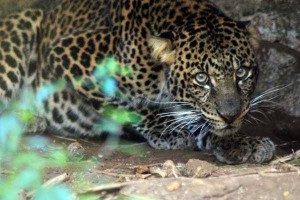 This leopard has 2 color variations, the bright one (orange with black-silver spots) and black with vague spots. The black color is the result of a recessive gene. In West Java, the black leopards are more common than the bright one, thus the people call them “macan kumbang”. This leopard is the identity of West Java.
This leopard has 2 color variations, the bright one (orange with black-silver spots) and black with vague spots. The black color is the result of a recessive gene. In West Java, the black leopards are more common than the bright one, thus the people call them “macan kumbang”. This leopard is the identity of West Java.
The Javan is the smallest of all leopards. They are solitary, except in the breeding season, they are nocturnal, hunting at night. Like other leopards, they like to bring their prey up on the tree. They are also excellent swimmers.
3. Orang Utan
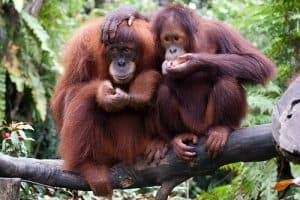 Indonesia Orangutans are arboreal apes, living in the trees. They feed primarily on fruit. Orangutans are known to be one of the most intelligent apes. They can use objects as tools for building nests.
Indonesia Orangutans are arboreal apes, living in the trees. They feed primarily on fruit. Orangutans are known to be one of the most intelligent apes. They can use objects as tools for building nests.
Adult males have large cheek-flaps, to show dominance to other males. Adult males are around 136 cm tall and 75 kg in weight, while adult females are around 115 cm tall and weigh 37 kg.
4. Anoa
 Since 1960, they are critically endangered. Today there are estimated to be less than 5000 individuals. The Anoa is often poached for its skin, horns and meat. Since 1986 the Anoa is recorded as one of the endangered animals.
Since 1960, they are critically endangered. Today there are estimated to be less than 5000 individuals. The Anoa is often poached for its skin, horns and meat. Since 1986 the Anoa is recorded as one of the endangered animals.
5. Indian Tapir
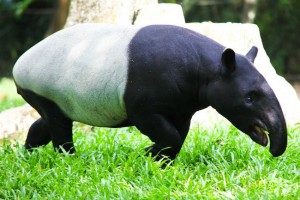 The Indian Tapir also has claws. There are 4 claws on each front leg and 3 claws on each back leg, to climb steep places. These kind of tapirs don’t have good sight, but their hearing and sense of smell are excellent.
The Indian Tapir also has claws. There are 4 claws on each front leg and 3 claws on each back leg, to climb steep places. These kind of tapirs don’t have good sight, but their hearing and sense of smell are excellent.
Tapirs are herbivores. They eat leaves and tubers. They move slowly in the forest, but they can flee rapidly when they sense any threats.
Also they like to stay near water, and they are excellent swimmers. Tapirs are crepuscular, means they are mostly active at dusk and sunset.
6. Javan and Sumatran Rhinoceros
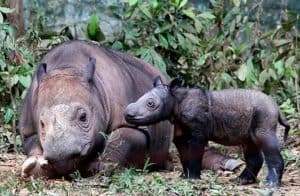 The Sumatran rhinoceros (Dicerorhinus sumatrensis) is the only Asian rhinoceros which has 2 horns. It is known as the “hairy rhinoceros”, due to its hairy skin. Sumatran rhinoceroses are easier to study than Javan rhinoceros.
The Sumatran rhinoceros (Dicerorhinus sumatrensis) is the only Asian rhinoceros which has 2 horns. It is known as the “hairy rhinoceros”, due to its hairy skin. Sumatran rhinoceroses are easier to study than Javan rhinoceros.
In the past, Sumatran rhinoceroses lived in India, Bangladesh, Bhutan, Southern China, and South-east Asia. But now they are extinct in many of those places, leaving only 6 populations of this rhinoceros: 4 in Sumatra, 1 in Malayan peninsula, and 1 in Kalimantan.
Both of these rhinoceroses are critically endangered, since there is a lot of poaching and habitat destruction for making palm fields. Poachers are killing this rhinoceros because of its horn, since traditional medicine experts believes that the horn can cure diseases. Many people take the horn for their own needs in order to maintain their health without any concern about Rhinoceroses existence.
7. Sumatran Elephants
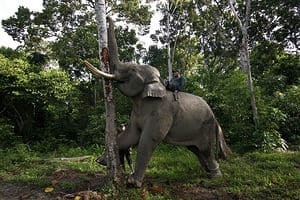 The Sumatran elephant (Elephas maximus sumatranus) is an Asian elephant, a sub-species which only can be found on Sumatra and Kalimantan Islands.
The Sumatran elephant (Elephas maximus sumatranus) is an Asian elephant, a sub-species which only can be found on Sumatra and Kalimantan Islands.
Sumatran elephants are smaller than Indian elephants. They are the biggest land-dwelling mammals in Indonesia. The elephants weigh around 6 tons and their shoulder height is around 3,5 meters. In captivity, they can reach 60 years of age. Today there is severe deforestation for making palm fields.
In 2000, the population in the wild was only 200-2700 individuals. The fast population decline is because there are many poachers looking for the tusks, and also due to habitat destruction.
8. Sun Bear
 »TheSun bear (Helarctos malayanus) belongs to the Ursidae family, and is the smallest of all bear species. This bear is the distinctive fauna of Bengkulu province (Sumatra) and the mascot of Balikpapan town (Kalimantan).
»TheSun bear (Helarctos malayanus) belongs to the Ursidae family, and is the smallest of all bear species. This bear is the distinctive fauna of Bengkulu province (Sumatra) and the mascot of Balikpapan town (Kalimantan).
The body length is around 1,4 m and shoulder height around 70 cm. The weigh is around 50-65 kg. Its fur is short and shiny, mostly black or dark brown. The eyes are brown or dark blue, the snout is big but short. On the neck, there’s half-circle marking with light-orange color, which is believed by the locals to be a “sunrise marking”. Also as their claws are long and sharp.
The Sun Bear is omnivorous, eating almost anything, from leaves, fruit, insects, honeycombs and small animals. They are nocturnal, foraging at night time. They are solitary animals. They are threatened by poachers and habitat destruction. Poachers are looking for their skin and gall bladder. Habitat destruction includes forest fires which occur every year in Sumatra and deforestation for making palm fields».
9. Mahakam Dolphins
 Mahakam dolphins (Orcaella brevirostris) are freshwater-dwelling dolphins, a subspecies of Irrawaddy river dolphins. In 2007, the population was only 50 individuals.
Mahakam dolphins (Orcaella brevirostris) are freshwater-dwelling dolphins, a subspecies of Irrawaddy river dolphins. In 2007, the population was only 50 individuals.
However in 2012, the population was growing, with 92 individuals. There are only 3 population of Irrawaddy dolphins in the world. In the Mahakam river, Mekong river, and Irrawaddy river.
They are carnivorous, eating smaller fish and shrimps. The head is round, with a grey body. The dorsal fins are small and round. It has no beak. It also uses ultrasonic communication like its relatives in the sea.
Nowadays, Mahakam dolphins are facing the extinction because of habitat destruction, for example river erosion and silting, increased boat numbers around the Mahakam estuary, also because they have to compete with fishermen for food.
10. Manta Rays
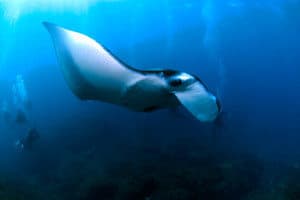 Indonesia is also a habitat of Oceanic Manta rays (Manta birrostris) and Coral Manta rays (Manta alfredi). They can be found in all the sea of the eastern side of Indonesia.
Indonesia is also a habitat of Oceanic Manta rays (Manta birrostris) and Coral Manta rays (Manta alfredi). They can be found in all the sea of the eastern side of Indonesia.
They are the biggest ray fish. Manta rays looks almost the same as their other ray fish relatives in broad chest fins and whip-like tails. The tails are shorter than any other ray, and they don’t sting. Manta rays also have bigger brain volume than their shark and ray fish relatives, making them more intelligent. The distinctive feature are are a pair of “horns” near the mouth.
The horns are actually cephalic fins, helping to take plankton-rich water into the mouth. Manta rays are endangered because of excessive fishing and destruction of corals.
11. Dugong
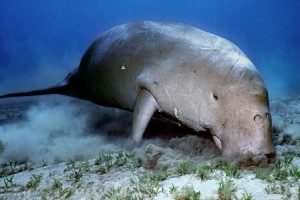 The Dugong (Dugong dugong) is a sea-dwelling mammal, included in the family Sirenia or sea-cow. It is the only herbivorous sea-dwelling mammal.
The Dugong (Dugong dugong) is a sea-dwelling mammal, included in the family Sirenia or sea-cow. It is the only herbivorous sea-dwelling mammal.
Most Dugongs live on the west side of Indonesia and northern Australia. It needs a large foraging area, shallow and calm water. Dugongs rely primarily on sea grass, making them never really go far away from their birthplace. For thousands years, dugongs have been hunted for their meat and fat. The habitat destruction is also making the population decrease rapidly.
Moreover, fishing activities can harm them. Other threats include storms, parasites, and predators such as sharks, and saltwater crocodiles.
12. Sharks
 Sharks are the apex predators, and they play an important role in keeping balanced sea-ecosystems. Since 2014, the Indonesian governments protects 6 species of endangered sharks and 2 species of manta rays. There are 4 species of endangered sharks which live in Indonesia. They are:
Sharks are the apex predators, and they play an important role in keeping balanced sea-ecosystems. Since 2014, the Indonesian governments protects 6 species of endangered sharks and 2 species of manta rays. There are 4 species of endangered sharks which live in Indonesia. They are:
- Sawfish ( Pristis spp).
- Whale shark (Rhincodon typus).
- Oceanic white-tip shark (Carcharhinus longimanus).
- Scalloped hammerhead (Sphyrna lewini).
Nowadays, shark populations are declining rapidly because of excessive fishing. Also there is a high demand for shark fins from Asian restaurants. The government ( in theory) regulates the trades of sharks as the key to protect these fundamental species.
13. Whales and Dolphins
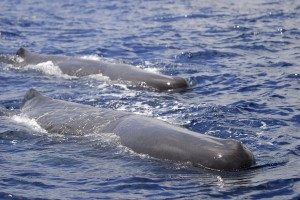 Indonesian law protects all the Cetacean family, whales and dolphins. This is because Indonesia follows the suggestion of CITES and IUCN, taking part in international sea-ecosystem conservation.
Indonesian law protects all the Cetacean family, whales and dolphins. This is because Indonesia follows the suggestion of CITES and IUCN, taking part in international sea-ecosystem conservation.
Located between 2 oceans (Indian Ocean and Pacific Ocean), Indonesia is the home and migrating routes of whales and dolphins. Nowadays whales populations are decreasing rapidly because of excessive commercial and sport hunting. Dolphins are declining too because of excessive fishing, making their foods more scarce as they have to compete with humans for foods.
One ethnic group in Nusa Tenggara, Indonesia, continues whale hunting as their cultural activity. The tradition still uses traditional tools, but it contributes to the decline of whale populations.
14. Sea Turtles
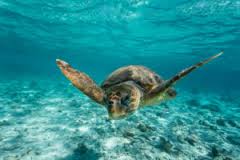 Sea turtles are also endangered animals. This is because of egg poaching and predators such as sharks, monitor lizards (eating the eggs), eagles (eating newborn turtles).
Sea turtles are also endangered animals. This is because of egg poaching and predators such as sharks, monitor lizards (eating the eggs), eagles (eating newborn turtles).
Indonesia is the nesting place of 4 species of sea turtles. The hawksbill sea turtle (Eretmochelys imbricata), Leatherback sea turtle (Dermochelys coriacea), flatback sea turtle (Natator depressus), Green sea turtle (Chelonia mydas), and loggerhead sea turtle (Caretta caretta).
In order to save the existence of sea turtles in their habitats, some sea conservation has been done. Some foreign NGOs (Non Government Organizations) are working with BKSDA (National natural resources conservation department) to preserve and increase the sea turtle population.
15. Cendrawasih (bird of paradise)
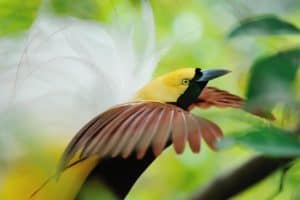 Cendrawasih (Paradisaea spp) are 7 species of birds native to the East side of Indonesia, Torres strait islets, Papua New Guinea, and Eastern Australia. The male birds have beautiful distinctive feathers, long and complex, growing from their heads, beaks, wings and tails.
Cendrawasih (Paradisaea spp) are 7 species of birds native to the East side of Indonesia, Torres strait islets, Papua New Guinea, and Eastern Australia. The male birds have beautiful distinctive feathers, long and complex, growing from their heads, beaks, wings and tails.
The birds, according to their species, have various sizes, from 50 grams weight to 430 grams. The best known of this species is the Yellow Bird of Paradise (Paradisaea apoda). Indigenous people often use the feathers in their traditional clothes.
In the 18-19 century AD, the feathers were important for making women’s hats in Europe. Still today poaching for feathers of Cendrawasih as well as their habitat destruction for tghe mining industry is making the population decline rapidly. Nowadays, the birds have legal protection worldwide, and hunting is only allowed for traditional uses.
16. Javan Hawk Eagle
 Javan eagle (Nisaetus bartelsi) is an endemic bird of Java island. This bird is also called Garuda, Indonesia’s national emblem.
Javan eagle (Nisaetus bartelsi) is an endemic bird of Java island. This bird is also called Garuda, Indonesia’s national emblem.
The Javan eagle is a medium-to-big bird, around 60-70 cm long. The head is reddish brown, with a crest pointing upward (2-4 pieces of feather). The back and wings are brown, the eyes’ iris is yellow or brown, with yellowish legs.
Today this bird is critically endangered. There are estimated to be only 137-188 pairs of birds in the wild. This is because of continuous habitat destruction and exploitation by irresponsible people.
17. Parrots
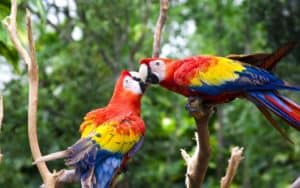 Parrots can be found in the wild in eastern Indonesia, around Sulawesi, East Nusa Tenggara, Maluku and Papua.
Parrots can be found in the wild in eastern Indonesia, around Sulawesi, East Nusa Tenggara, Maluku and Papua.
These birds consist of 3 families: cockatoo, lories and New Zealand parrots. The ones that can be found in Indonesia are cockatoo and lories.
Nowadays, these birds face extinction in a severe crisis because of excessive poaching and the animal trade. In the animal trade alone, only one-fifth of the poached birds arrive and survive safely with their owners.
Endangered cockatoos in Indonesia are 5 species: cook cockatoo (Cacatua galerita), yellow-crested cockatoo(C.sulphurea), Tanimbar cockatoo(C.coffini), Maluku Cockatoo(C.moluccensis), and the most endangered one, King cockatoo(Probosciger aterrimus).
The lories are the black-capped lory (Lorius lory), ornate lorikeet (Trichoglossus ornathus), Kabare lory(Psittirichas fulgidus), and the Talaud lory (Eos histrio).
18. Maluku Maleo Bird
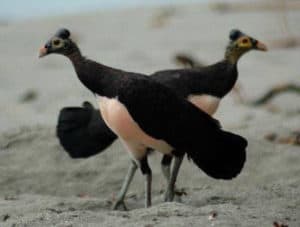 The Maluku Maleo bird (Eulipoa wallacei) is the smallest of all the maleo birds, with a length of around 31 cm, and the only living species of the genus Eulipoa.
The Maluku Maleo bird (Eulipoa wallacei) is the smallest of all the maleo birds, with a length of around 31 cm, and the only living species of the genus Eulipoa.
The bird has brown-olive colored feathers, the skin around the face is light yellow, eyes’ iris are brown, dark legs, greyish-yellow beak, ventral feathers are darkblue-grey, and white tail.
Nowadays, the population of this fascinating birds is only found in mountain forests of Maluku and Misool island in West Papua. The bird lays eggs at night.
The bird makes its nest in opened sandy area, and usually around volcanoes and areas where there are geothermals. The bird faces extinction because of deforestation.
19. Hornbills
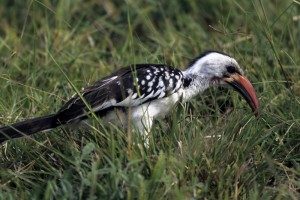 Hornbills (bucerotidae) are a kind of birds which has a distinctive beak. The beak has a horn-like form, but without any circle. Its usually a bright color. Hornbills are divided into 14 genus and 57 species. 9 of the species are endemic to Africa, and 13 species are endemic to Indonesia.
Hornbills (bucerotidae) are a kind of birds which has a distinctive beak. The beak has a horn-like form, but without any circle. Its usually a bright color. Hornbills are divided into 14 genus and 57 species. 9 of the species are endemic to Africa, and 13 species are endemic to Indonesia.
These birds are omnivorous, eating fruits, bats, lizards, insects, mice and small snakes. The male and female birds work together to make nests and raise the chicks. Nowadays, the Hornbill population is declining rapidly because of habitat destruction and poaching for their beaks.
20. Komodo Dragons
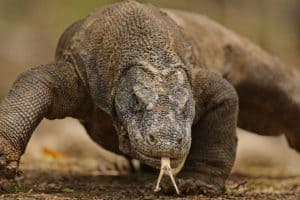 Komodo dragons (Varanus komodoensis), are the biggest living lizards on earth. They are native to Komodo, Rinca, Flores, Gili Motang, and Gili Dasami islands in Nusa Tenggara (known as Lesser Sunda Islands). They can reach 3 meters long and more than 136 kg in weight.
Komodo dragons (Varanus komodoensis), are the biggest living lizards on earth. They are native to Komodo, Rinca, Flores, Gili Motang, and Gili Dasami islands in Nusa Tenggara (known as Lesser Sunda Islands). They can reach 3 meters long and more than 136 kg in weight.
They are carnivorous, eating carrion, deer, pigs, buffalo and humans. They even show cannibalistic behaviour by eating smaller dragons. The dragon’s saliva is venomous, making the victims who escape the bite die of blood poisoning. The dragons also have shark-like teeth to bite their prey.
The population is stable, around 3000-5000 individuals. The endangered status is given because the population is concentrated only in Lesser Sunda Islands, the death of egg-laying females, poaching, destroyed habitat, and natural disasters.
21. Binturong
 Binturong (Arctictis binturong) is a big civet cat. It is also called Malay Civet Cat, Asian Bearcat, Palawan Bear Cat, or simply Bear cat.
Binturong (Arctictis binturong) is a big civet cat. It is also called Malay Civet Cat, Asian Bearcat, Palawan Bear Cat, or simply Bear cat.
The “bear cat” name is probably given because this black carnivorous mammal looks like a bear with a long tail, and has long whiskers like cat.
The length between head and body is 60-95 cm, while the tail is 50-90 cm long. The weight is between 6-20 kg. Their tails can be used to grab tree branches (prehensile tail).
The Binturong is poached to take its thick-furred skin, and to use its body parts as folk medicine. Deforestation is also making the population decline. This animal has protected status from the Indonesian government.
22. Tarsius
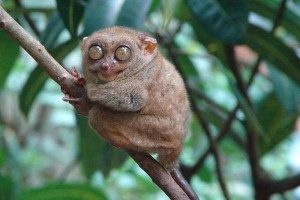 The Tarsius is the smallest primate in the world. There are 9 species of tarsius in the world; 2 species in the Phillipines and 7 species in Sulawesi, Indonesia. The most well known ones in Indonesia are Tarsius tarsier and Tarsius pumilus (pygmy tarsius). All species of tarsius are endangered and »protected» by the Indonesian government.
The Tarsius is the smallest primate in the world. There are 9 species of tarsius in the world; 2 species in the Phillipines and 7 species in Sulawesi, Indonesia. The most well known ones in Indonesia are Tarsius tarsier and Tarsius pumilus (pygmy tarsius). All species of tarsius are endangered and »protected» by the Indonesian government.
Tarsius tarsier has a body length of 10-15 cm and weight of around 80 grams. The pygmy tarsius is only 93-98 mm long and 57 grams in weight. Their tails are 197-205 mm. They also have heads that can be turned 180 degree to left and right.
They are nocturnal animals. They are carnivorous, eating insects, small reptiles and bats. However, the population is declining rapidly because of deforestation, and hunted by humans. Moreover, many native young men like to consume Tarsius with alcohol. Tarsius are also difficult to breed outside their habitat. They are known to do self-mutilation because of stress in confinement.
23. Babirusa
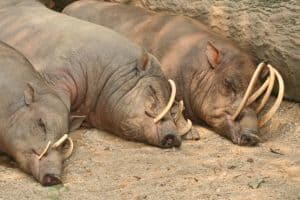 The Babirusa (Babyrousa babirussa), also called the deer-pig, can only be found around Sulawesi and Maluku. Their habitat is tropical forest.
The Babirusa (Babyrousa babirussa), also called the deer-pig, can only be found around Sulawesi and Maluku. Their habitat is tropical forest.
They are omnivorous, but mostly eat plants, fruits and mushrooms. They only forage at night to avoid predators. They are often hunted for their meat, or simply killed because they destroy human’s plantations and fields.
TRhe body length is 87-106 cm, the shoulder height is 65-80 cm, and the weight can reach 90 kg. They live in small groups with an alpha male as a leader.
The population is declining, now there only estimated around 4000 individuals, and they only exist in Indonesia. They IUCN and CITES protection since 1996.
24. Muntjac
 The Muntjac, or barking deer (kijang in Indonesian) are the relatives of deer which are included in the genus Muntiacus. Barking deer are from the Old World and regarded as the oldest type of deer.
The Muntjac, or barking deer (kijang in Indonesian) are the relatives of deer which are included in the genus Muntiacus. Barking deer are from the Old World and regarded as the oldest type of deer.
They have existed for 15-35 million years, with their remains found in the Miocene era in France and Germany. Today, barking deer can only be found in South Asia and South-east Asia, from India, Srilanka, Indochina, to Indonesia. Some species were introduced to England and now they can be found easily there. Barking deer don’t have a breeding season and they can breed anytime.
25. Mouse-deer
 ‘Mouse-deer is a name for a group of mammals in genus Tragulus. They are close relatives to deer, but much smaller. Their body is just as big as a rabbit. They inhabit tropical rainy forest in South-east Asia, including Indonesia.
‘Mouse-deer is a name for a group of mammals in genus Tragulus. They are close relatives to deer, but much smaller. Their body is just as big as a rabbit. They inhabit tropical rainy forest in South-east Asia, including Indonesia.
They are the smallest ungulates in the world. They look like a deer, but much smaller, without antlers.
The legs are slender with an ached back. The body length is around 195-300 mm, and the back legs are around 110-150 mm long.
They are endangered because they are hunted excessively for their meat, and trapped and killed because they destroy vegetable fields’.
Others
continues here, without photos or corrected English: https://factsofindonesia.com/endangered-animals-in-indonesia
»Indonesia is not only rich in cultures, but also rich in animals. Some of these endangered animals are apex predators, which play an important role in balancing ecosystems.
As a younger generation, we should try to contribute to conservation programs wherever we are in the world. Some ways to do that are not to buy any endangered animals as pets, stop eating shark-fin soups, and stop using animal furs as clothes.
If each person in the world does those things, the population of endangered animals will increase and our next generation will still be able to see these animals».


2 opiniones en “Climate, Fires and Capitalism Wiping Out Indonesia’s Wonderful Animals”